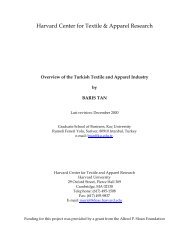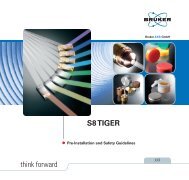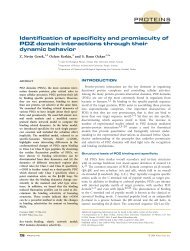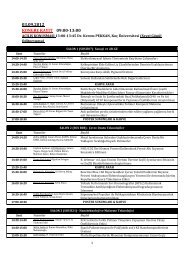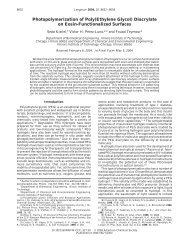The Bioartificial Pancreas: Progress and Challenges Review
The Bioartificial Pancreas: Progress and Challenges Review
The Bioartificial Pancreas: Progress and Challenges Review
Create successful ePaper yourself
Turn your PDF publications into a flip-book with our unique Google optimized e-Paper software.
THE BIOARTIFICIAL PANCREAS 971<br />
membrane, which was then surrounded by an<br />
outer polyethyleneimine coating. In later studies,<br />
the outer layer was replaced by the more<br />
biocompatible alginate coating because of an<br />
inflammatory reaction induced by polyethyleneimine.<br />
51 Since then, a variety of studies have<br />
been performed to underst<strong>and</strong> the requirements<br />
for successful transplantation of encapsulated<br />
islet cells, but there is still a need for<br />
convincing evidence of success of encapsulated<br />
islet transplantation in either non-human primates<br />
or humans. 49<br />
IMPEDIMENTS TO THE PROGRESS OF<br />
CELL ENCAPSULATION TECHNOLOGY<br />
Fibrotic overgrowth of the implanted microcapsules<br />
is one of the major obstacles to progress<br />
in cell encapsulation technology. Invariably,<br />
the materials used for encapsulation are<br />
not completely inert, <strong>and</strong> can induce foreign<br />
body <strong>and</strong> inflammatory reactions. As a result of<br />
this fibrous tissue overgrowth, the diffusion of<br />
nutrients, oxygen, hormones, <strong>and</strong> waste products<br />
through the capsule is diminished, <strong>and</strong> encapsulated<br />
islets are destroyed because of hypoxia,<br />
starvation, <strong>and</strong> the secretion of nitric<br />
oxide by the stimulated macrophages. 52 This fibrotic<br />
reaction to implanted microcapsules had<br />
previously been associated with commercially<br />
available alginate with high mannuronic acid<br />
content, which activates macrophages in vivo,<br />
resulting in fibroblast proliferation <strong>and</strong> eventual<br />
overgrowth. 53 However, later studies did<br />
not support that notion. 33 It has also been<br />
shown that polylysine may cause a fibrotic response<br />
through the induction of cytokines. 54<br />
Another important component of capsular<br />
design is permselectivity. Most capsule designs<br />
are based on the presumption that the effectiveness<br />
of immunoisolation of a polymer capsule<br />
is closely related to the pore size of the capsule<br />
membrane. 55–57 However, pore sizes of<br />
polymer membranes are not homogeneous by<br />
nature, <strong>and</strong> consist of a broad spectrum of<br />
sizes. 58 Total immunoprotection of encapsulated<br />
cells can only be provided if the polymer<br />
membrane does not have any pores larger than<br />
the antibody complement component. 59 This<br />
fact has been largely ignored by researchers<br />
<strong>and</strong> has resulted in inconsistent findings in the<br />
field. 60–66<br />
Mechanism of immunologic attack of allografts<br />
<strong>and</strong> xenografts<br />
With regard to specific immunologic attack<br />
of encapsulated cell implants, there are differences<br />
in the immune protection requirement of<br />
allografts versus xenografts. An allograft is a<br />
graft between genetically different individuals<br />
within the same species, while a xenograft is a<br />
graft between individuals from different<br />
species. Allograft rejection occurs as result of<br />
activation of cellular immunity by interactions<br />
of host T cells with a graft, while humoral immunity,<br />
including antibodies <strong>and</strong> complement<br />
proteins, is responsible for the rejection of<br />
xenografts. 67,68 In the direct pathway of antigen<br />
presentation, the T cell receptor recognizes<br />
T cells presented by donor-type antigen-presenting<br />
cells along with Class I or II major histocompatibility<br />
complex (MHC) molecules.<br />
<strong>The</strong> idea of immunoisolation using a polymer<br />
membrane is to separate allogeneic or xenogeneic<br />
tissue from the immune system of the<br />
recipient. <strong>The</strong>refore, microencapsulation of<br />
islets within effective permselective membranes<br />
would prevent contact with immunoglobulin,<br />
complement components, <strong>and</strong><br />
inflammatory cells. However, there is also a potential<br />
immune response towards antigens<br />
shed by encapsulated allogeneic or xenogeneic<br />
cells. Such antigens could be therapeutic agent<br />
themselves, cell surface molecules, or cell components<br />
(phospholipids, DNA), including<br />
those released upon cell death. Shedding of<br />
antigens from encapsulated cells would initiate<br />
a molecular tissue response around the implant,<br />
which could affect the viability <strong>and</strong> function<br />
of the encapsulated cells. As a result of this<br />
immunological reaction, these shedded antigens<br />
may be internalized, processed, <strong>and</strong> presented<br />
in association with host Class II MHC<br />
molecules (macrophages <strong>and</strong> dendritic cells) to<br />
host CD4 helper T cells (Fig. 1). <strong>The</strong> recognition<br />
of antigens through this indirect pathway<br />
may lead to the activation of T helper cells,<br />
which then secrete cytokines <strong>and</strong> regulate cellmediated<br />
immune response <strong>and</strong> inflammation.<br />
69,70 Small molecules, such as reactive oxy-



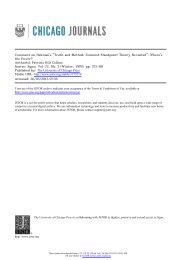
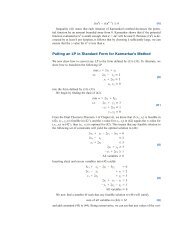
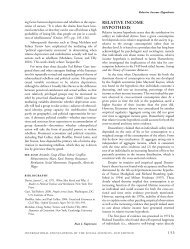
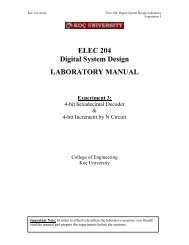
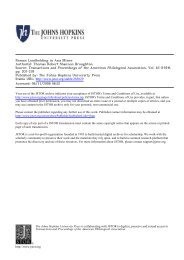
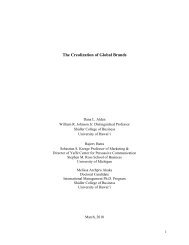
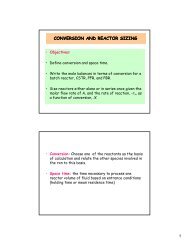
![]_[O](https://img.yumpu.com/10363126/1/190x138/-o.jpg?quality=85)
